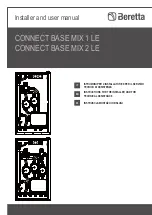
7
General Information
1.8 - WATER TREATMENT
The chemical-physical characteristics of the filling water and
reinstatement water in heating systems are of fundamental
importance for guaranteeing correct and safe boiler operation.
Before filling the CH circuit with water, it is necessary to analyse
the water and decide for a proper treatment.
The purpose of this treatment is finalized to eliminate or sub-
stantially reduce the following problems:
- lime scale deposit
- corrosions
- deposits
- biological growths (moulds, bacteria, algae, fungi, etc)
The chemical treatment of the network water enables the
prevention of these problems and guarantees safe boiler
operation and economical advantages, in terms of mainte-
nance and global thermal efficiency.
The chemical analysis of the water enables us to obtain a lot
of information on the system’s condition and state of “health”.
It is essential to avoid any problems with the boiler.
The pH is a measure of the acidity or alkalinity of a solution.
The pH scale has a range of 0-14, where 7 is neutral.
Values inferior to 7 indicate acidity, values above 7 indicate
alkalinity.
The ideal pH value for water in heating systems fitted with
aluminium boilers is between 6,5 and 8, with a hardness
of 15°F.
In heating systems where the water has a value outside this ran-
ge, this considerably accelerates the destruction of the protective
oxidized layer which naturally develops inside the aluminium
bodies: if the pH is below 6, acidity is present, if it is above 8,
the water is alkaline or it is caused by an alkaline treatment (for
example phosphate or glycol used as an antifreeze) or in several
cases it is due to the natural formation of alkaline in the system.
Vice versa, if the pH value is between 6,5 and 8, the aluminium
surfaces of the boiler body are passivated and protected from
further corrosive attacks.
To minimize corrosion it is essential to use a scale inhibitor,
however in order for this to function correctly, the metallic
surfaces have to be clean.
The best corrosion inhibitors on sale also contain a pro-
tective system for aluminium which acts by stabilizing the
water’s pH value, preventing unforeseen variations.
We recommend that the heating system’s water pH value is
systematically controlled (minimum twice a year). In order
to do this, it is not necessary to run a chemical analysis in a
laboratory, but it is sufficient to use a simple analytical ‘kit’
contained in portable cases, easily found on sale.
Therefore, prior to filling the heating system with water it will be
necessary to fit the devices indicated in the figure below.
THE CONNECTION MUST BE FITTED ON THE
PRIMARY CIRCUIT’S RETURN PIPE DOWN-
STREAM OF THE CIRCULATING PUMP
All the necessary precautions must be taken in order to avoid
the formation and localization of oxygen in the system’s water.
For this reason, the plastic pipes used in underfloor heating
systems must be impermeable to oxygen.
If any antifreeze solutions are used ensure yourself that they are
compatible with aluminium and with any other components and
materials fitted on the system.
WARNING!
ANY DAMAGE CAUSED BY THE BOILER,
DUE TO THE FORMATION OF LIME SCALE
OR DUE TO CORROSIVE WATER WILL INVA-
LIDATE THE APPLIANCE WARRANTY.
1. Ball valve
2. Inspection pocket
3. Filling-up group
4. Disconnector
5. Scale reducing device
6. Litrecounter
(recommended)
7. “Y” filter
EXAMPLE OF SCALE REDUCING DEVICE CONNECTION FOR WATER TREATMENT
Summary of Contents for MODULEX EXT 100
Page 1: ...E N G L I S H 100 150 200 250 300 350 INSTALLATION AND SERVICING INSTRUCTIONS MODULEX EXT ...
Page 32: ...32 Instructions for the installer THERMOSTAT FBR 2 CONNECTION room sensor ...
Page 33: ...33 Instructions for the installer MODULATING THERMOSTAT CONNECTIONS ...
Page 35: ...35 Instructions for the installer ...
Page 37: ...37 Instructions for the installer Sensor terminal assignments Terminal assignments BCM ...








































